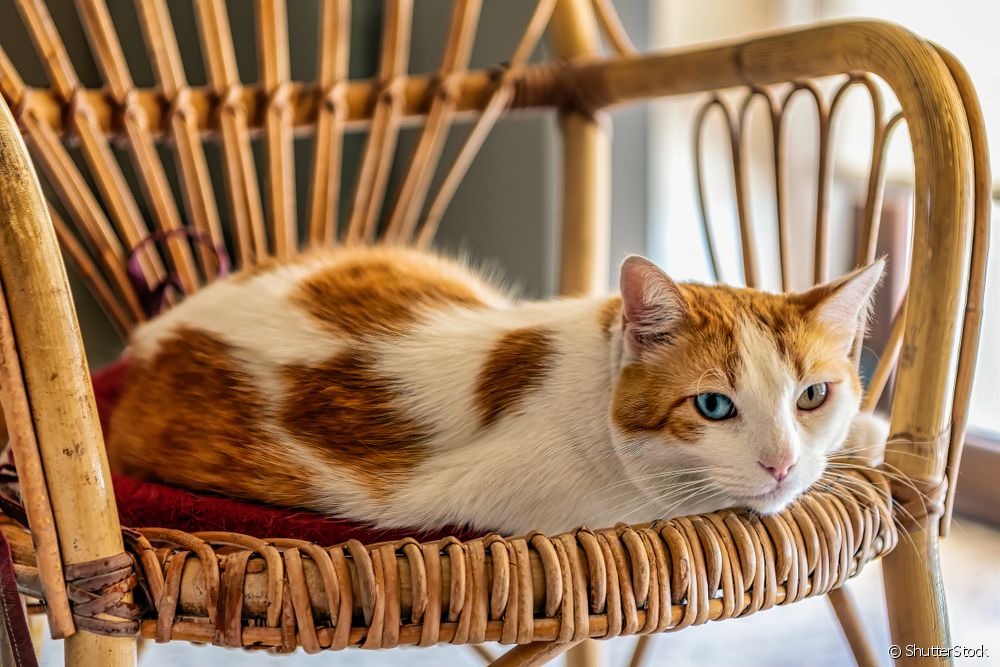Cat with heterochromia: understand the phenomenon and the necessary health care

Table of contents
You may have seen a cat with one eye of each color, right?! This characteristic, called heterochromia, is a genetic condition that can occur in kittens, dogs and humans. But did you know that in some cases, this charm in the cat's eye can cause some problems in the cat's health? We talked to veterinarian Amanda Carloni, postgraduate in clinical practicecat and dog doctor and specialized in preventive veterinary medicine. She explained everything about cat with heterochromia!
Cat with heterochromia: how does it develop?
Also known as "odd-eye cat", the phenomenon of heterochromia is a change in the coloration of the iris - it can occur in both eyes or only in one. There are different types of heterochromia in cats, as veterinarian Amanda explains: "it can be complete (each eye has a different color), partial (two different colors in the same eye), or central (a "ring" of different color surrounds the iris).This condition is, in most cases, congenital, of a hereditary nature, and should not cause any astonishment or concern to the guardian, since the kitten does not feel any discomfort or inconvenience.
"A cat with genetic heterochromia has inherited from its family a gene responsible for a decrease in the amount of melanocytes (cells that produce melanin) and therefore usually has blue eyes, light skin and is white or has white spots," explains the specialist. However, she says that heterochromia in cats can also develop due to an accident or pathology: "In this case, the cat"The cat's eyes acquire a different coloration due to the presence of scars that can make the eye whitish, bluish or with spots," he says. In any case, it is necessary to observe and take some care with felines, especially the blue-eyed cat.

Cat with heterochromia: condition can create some problems in the kitty
In most cases, heterochromia does not cause any problems for the animal, but there is the possibility of the emergence of diseases that may be associated with genetics and cat breeds. "In genetic cases, this is just a characteristic of the cat and therefore does not cause altered function or discomfort in the affected eye. However, in acquired cases, heterochromia is often a clinical sign ofsome pathology, it is important to ask for the help of a veterinarian to help the kitten ", explains the veterinarian.
If you notice a sudden change in the color of your cat's eye, it is necessary to seek a veterinarian to diagnose if there is no associated problem. According to the veterinarian, in the case of a sudden change in the color of the eye, the cat may be facing various eye diseases, such as injuries and even neoplasms. The veterinarian also points out that some breeds may be more prone todevelop heterochromia in cats. "However, it is worth noting that the breed alone will not define whether a cat will have heterochromia. For this to occur, the cat must have the gene responsible for the decrease in the amount of melanocytes," he explains. Among these breeds are:
See_also: Bathing tips: how to choose the best dog soap?- Angora;
- Persian;
- Japanese bobtail;
- Turkish van;
- Siamese;
- Burma;
- Abyssinian.
White cat with blue eyes may have deafness!
In the case of the white cat, blue eyes can be indicative of deafness. This characteristic is genetically termed. "We cannot say that the blue-eyed white cat will always have deafness, because biology is not an exact science! But, yes, there is a higher incidence of deafness in these cats. This is because the gene responsible for the decrease in the amount of melanocytes also usually causes deficiencieshearing," explains veterinarian Amanda.
The condition of heterochromia is more common in some specific cat breeds, which tend to have a light coat and blue eyes. This is the case with the Siamese, the Burmese, the Abyssinian and the Persian cat. It can also occur when the cat has only one blue eye. "When the cat is still a kitten, some cells in its eyes can turn into melanocytes,If this occurs in only one eye, that eye will be darker, while the other remains blue," he adds. In this case, the condition of deafness may be present only on the side of the lighter eye.

